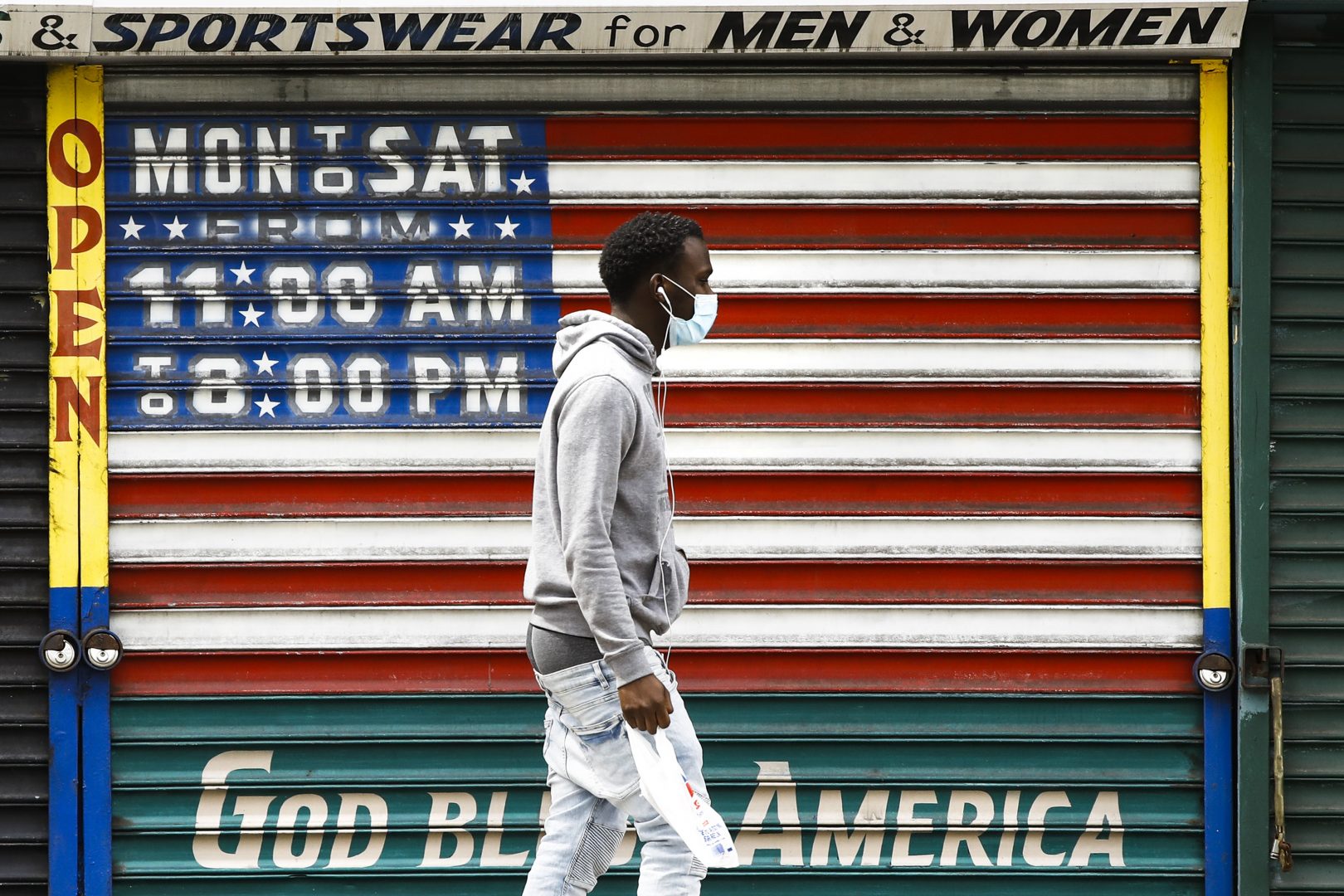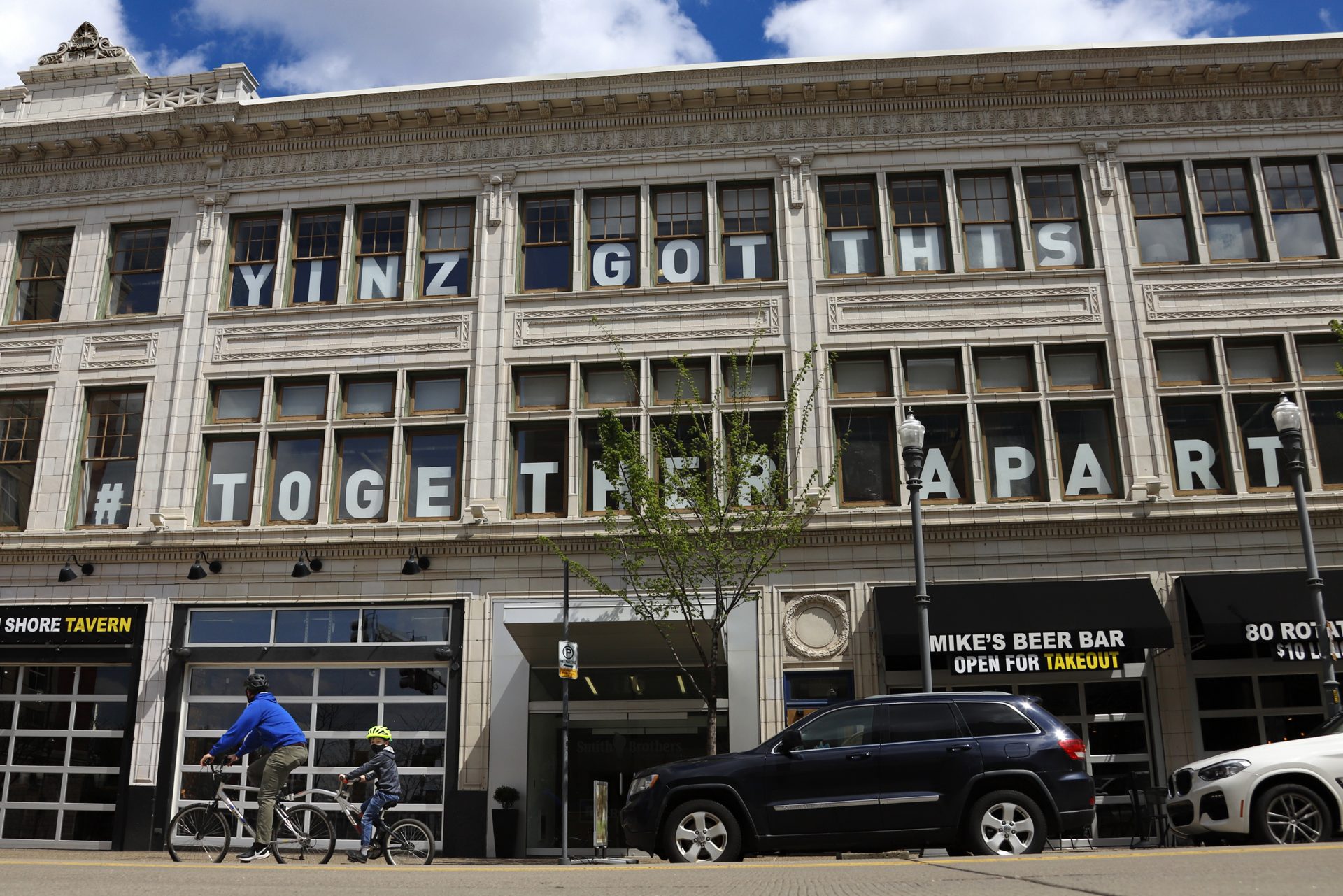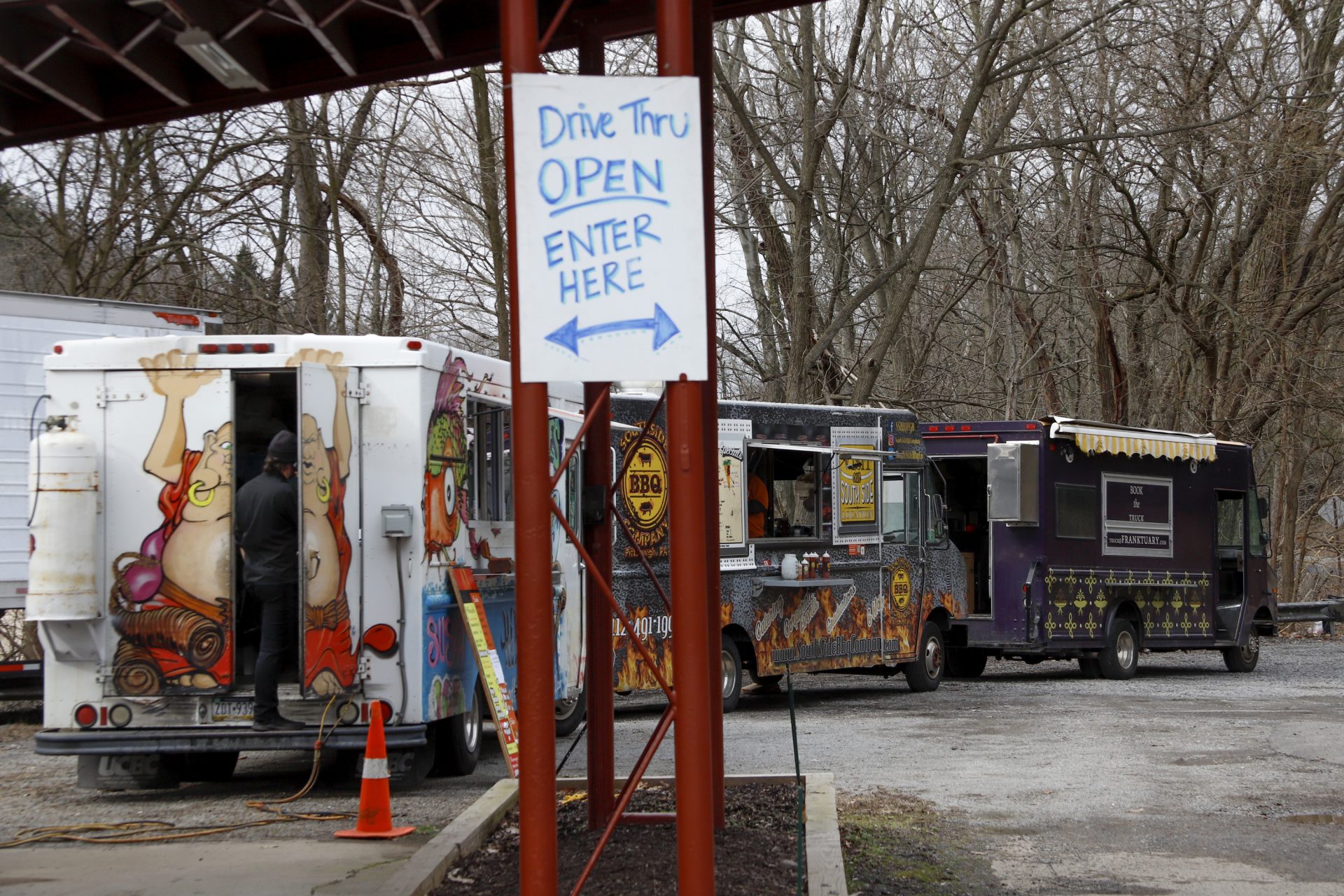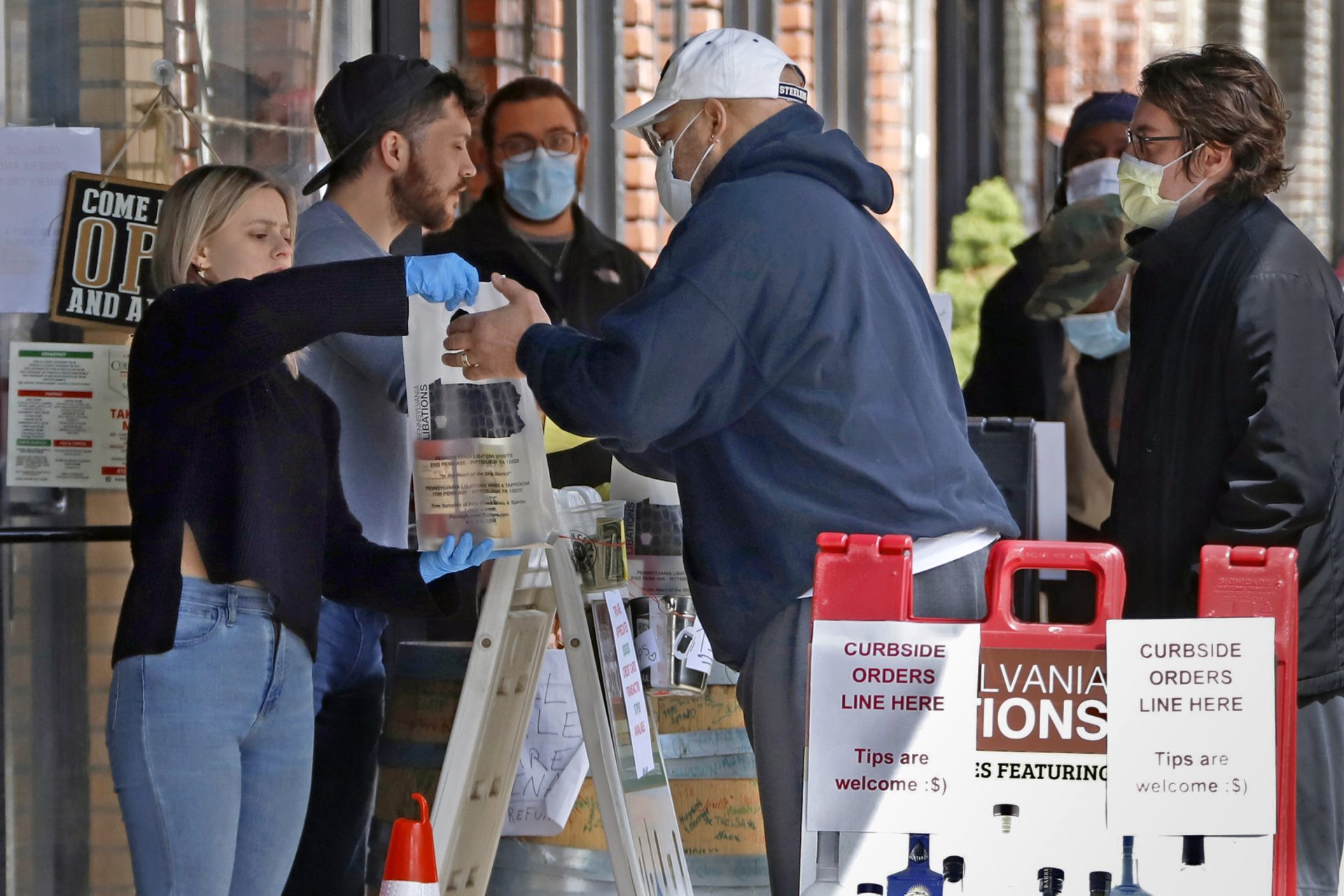
A person wearing a protective face mask as a precaution against the coronavirus walks past a shuttered business in Philadelphia, Thursday, April 23, 2020.
Matt Rourke / AP Photo

A person wearing a protective face mask as a precaution against the coronavirus walks past a shuttered business in Philadelphia, Thursday, April 23, 2020.
Matt Rourke / AP Photo

Matt Rourke / AP Photo
A person wearing a protective face mask as a precaution against the coronavirus walks past a shuttered business in Philadelphia, Thursday, April 23, 2020.
What you should know
» Coronavirus facts & FAQ
» Day-by-day look at coronavirus disease cases in Pa.
» What the governor’s stay-at-home order means
Some regions of Pennsylvania are tantalizingly close to escaping some pandemic restrictions. Other parts of the state could have a long way to go before residents and businesses begin getting back to normal.
As the administration of Gov. Tom Wolf considers when to allow residents to leave their homes and shuttered businesses to reopen, an analysis by The Associated Press shows how the state’s sprawling geography and highly variable population density are playing a big role in the shutdown calculus.
Wolf has said a swath of rural northern Pennsylvania — spanning some 230 miles (370 kilometers) from east to west — is likely to begin moving out from under his shutdown orders on May 8. That is partly based on a metric in Wolf’s reopening plan that says new infections of the coronavirus must total no more than 50 for every 100,000 residents over a two-week period.
It’s a different story in densely populated eastern Pennsylvania. In the southeast, which includes Philadelphia and its tightly packed suburbs, residents are still contracting the virus at a rate nearly five times above the state’s threshold to be considered for shutdown relief. And the northeast region, which includes Allentown, Scranton and Wilkes-Barre, is still four times over the state threshold.
Wolf’s gradual, color-coded reopening plan divides Pennsylvania’s 67 counties into six geographic regions. All of Pennsylvania has been red, meaning all 12.8 million residents are under orders to stay home and all businesses deemed “non-life-sustaining” are closed to help contain the virus, which has infected more than 38,000 people and killed more than 1,400 statewide.
Under Wolf’s plan, regions will move together from red to the less restrictive yellow, and then, eventually, to green, meaning that all pandemic shutdown orders are lifted except to the extent that federal or state health guidelines remain in place to limit the virus’s spread.
Speaking to reporters Thursday, Wolf acknowledged the southeast region will likely be the last to move from red to yellow. Neither Wolf nor his health secretary could say when the southeast’s 5.2 million residents might see shutdown relief.
“The goal here is to keep people safe. It’s not to impose unneeded, arbitrary restrictions on people’s freedom of movement. We’re trying to keep people safe, and we’re being driven by the dictates of this virus,” he said.
The capital region of south-central Pennsylvania, meanwhile, is fairly close to meeting the case threshold, at about 74 new infections reported per 100,000 people over the past two weeks.
In the southwest, which includes Pittsburgh, only about 31 additional people per 100,000 were reported to have contracted the virus in the latest 14-day period. But the region includes a county on the Ohio border, Beaver, which is dealing with a large outbreak at a nursing home that has spiked its overall infection rate. Health officials say they’re taking that special circumstance into account as they decide whether the Pittsburgh area is ready to begin reopening.


Officials say the incidence of new cases isn’t the only metric they’re looking at. Expanded virus testing, sufficient hospital capacity and the ability to quickly identify and contain flareups through what’s known as contact tracing must also be in place. The state Department of Health will also use a new modeling tool by Carnegie Mellon University to help them decide when a region is ready to reopen.
Republicans are pressing Wolf, a Democrat, to reopen the state’s battered economy more quickly and broadly. U.S. Sen. Pat Toomey, a Pennsylvania Republican, released a plan that says most of the state should immediately resume some economic activity. Nearly 1.6 million Pennsylvanians have filed for unemployment compensation since mid-March.
Wolf acknowledged that a decision on when to allow a region to reopen is both art and science, with a high degree of uncertainty thrown in.
“I’m trying to do this in a logical, reasoned, sequential, cadenced way, but recognizing that ultimately there’s going to be a measure of subjectivity to this whole thing,” he said.
Pennsylvania’s COVID-19 death toll rose by 71 to 1,492, the state health department reported Friday, with about 1,600 additional people testing positive for the virus that causes the disease.
Statewide, more than 38,600 people have tested positive, according to the latest Health Department data. The number of infections is thought to be far higher because many people have not been tested, and studies suggest people can be infected with the virus without feeling sick.
A total of 6,736 people in central Pennsylvania have tested positive for the virus or probably have the virus since the first cases were reported in the region on March 13. Of those, 218 residents who tested positive have died.
Today’s update includes three newly reported deaths in Dauphin, two in Lancaster, one in Berks, one in Cumberland and one in York.
For most people, the virus causes mild or moderate symptoms that clear up in a couple of weeks. Older adults and people with existing health problems are at higher risk of more severe illness, including pneumonia, or death.

Gene J. Puskar / AP Photo
In this April 16, 2020 photo people line up to purchase Pennsylvania made liquor at Pennsylvania Libations in Pittsburgh’s Strip District. The Pennsylvania liquor control board closed the Pennsylvania state-owned stores that retail nearly all of Pennsylvania’s liquor in March, driving up demand from the state’s distilleries, which have been allowed to continue production and sales, although some report stockpiles are rapidly drying up.
Hundreds more state-owned liquor stores will be open for curbside pickup starting Monday, the Pennsylvania Liquor Control Board announced.
The agency said it is expanding curbside pickup to 389 additional Fine Wine & Good Spirits stores across the state, meaning that nearly all of the state’s liquor stores will now offer the service.
The move to expand curbside pickup follows Wolf’s unpopular closure of the state-owned liquor stores. The state’s online ordering system has been unable to keep up with overwhelming consumer demand, though it has recently increased capacity.
Most stores will offer curbside service Monday through Saturday. Stores will take orders by phone, accepting the first 50 to 100 orders placed each day. Each customer is limited to no more than six bottles.
In its first four days, the curbside pickup program filled 38,145 orders totaling $3.64 million, according to the liquor board.
The York County Food Bank is partnering with The Well of Glen Rock to hold a drive-through food distribution event from 12:30 to 2 p.m. Saturday at 139 Manchester St., Glen Rock. Every household will receive a food box with enough food to feed a family of four for four or five days. Boxes will include pantry items as well as fresh and frozen foods, including meat, produce and dairy.
For health and safety reasons, the food bank requests that only one person per household attend the event, and that each attendee clears out their trunk out so volunteers can easily load food into vehicles.
The Well of Glen rock is also giving out hot meals from 11:30 a.m. to 1 p.m. every weekday at 32 Water St.
The Hershey Company is planning to acquire, install and staff a new manufacturing line dedicated to the production of disposable facemasks.
The company estimates the manufacturing line will be operational by the end of May and be capable of producing up to 45,000 masks per day.
With outdoor planting season here for parts of Pennsylvania, Republican state lawmakers are beginning to press legislation to force Gov. Tom Wolf’s administration to allow garden centers to open even while the state is shut down to contain the spread of the coronavirus.
Some garden centers remain shuttered under Wolf’s statewide March 19 order for “non-life-sustaining” businesses to close. But gardeners are beginning planting outdoors for the summer growing season, and relaxing that order could be weeks away for much of Pennsylvania.
Meanwhile, plants, seedlings and other garden supplies are being sold by big-box stores or competitors that may sell hardware, farm supplies, building materials or other qualifying goods that allow them to stay open.
On Friday, four Republican state senators said they will introduce legislation to force Wolf’s administration to issue waivers from the orders so that garden centers can reopen while adhering to social distancing and other guidelines issued by the U.S. Centers for Disease Control to protect employees and customers.
“With the seasons quickly changing, we can no longer afford to wait to have these important businesses approved for waivers to open,” Sen. Ryan Aument, R-Lancaster, said in a statement. “The summer and fall harvests may be weeks and months away, but the seeds needed to grow into what will eventually become hundreds of millions of pounds of produce for our communities need to be planted soon.”

A collection of interviews, photos, and music videos, featuring local musicians who have stopped by the WITF performance studio to share a little discussion and sound. Produced by WITF’s Joe Ulrich.
The days of journalism’s one-way street of simply producing stories for the public have long been over. Now, it’s time to find better ways to interact with you and ensure we meet your high standards of what a credible media organization should be.